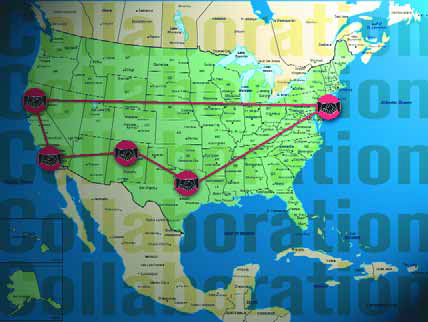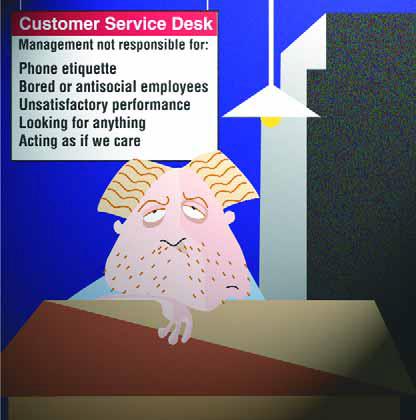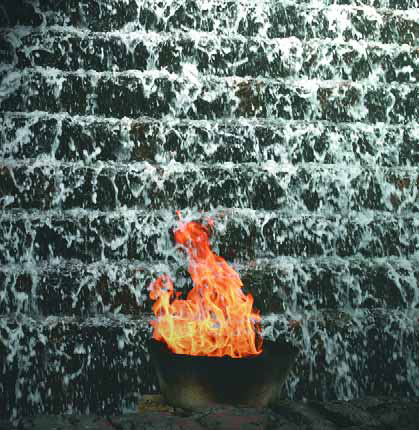communication
On several occasions during the past few years, I've had the privilege of working with talented professionals who have made it possible for me to operate comfortably far from my home base on what have often been extremely ambitious projects. In fact, I've found some of my most exciting and rewarding recent jobs have been the result of these collaborations with other watershapers. Although working with them is different from
It's amazing how many people I meet in the course of my day-to-day life who do not embrace the basic idea that the single most important part of doing business is how they interact with current and prospective clients. Way too often, I'll run into someone - usually an employee, but sometimes (and shockingly) a manager or owner - who just doesn't have a clue or really doesn't seem to care. This happens so often, in fact, that I find my patience growing shorter with the laziness, incompetence or downright rudeness I encounter. It's gotten to the point where I'm
As watershape designs become ever more creative and adventurous, there's an increased need to help clients and other project participants visualize our plans. Indeed, presentation is a topic of great importance these days for designers from both the pool/spa industry and the landscape trades, so much so that it's become a fixture on educational calendars and one of the cornerstones of the Genesis 3 curriculum. What has everyone excited about upgrading the way they present their ideas is that there are various good ways to get the job done. To be sure, having the ability to draw is a tremendous asset - some would say an absolute necessity - but fortunately for those who are
When I was a kid, I was obsessed with hot rods. I suspect this resulted from my dad's subscriptions to magazines such as Road & Track and Street Rod: I was mesmerized by
I found a new "favorite" plant last summer. It's called Dalechampia dioscorefolia, otherwise known as the Costa Rican Butterfly Vine. Its stunningly beautiful, exotic flowers were unlike those on any of the vines I typically see at nurseries and easily earned a place in my disorganized (and experimental) backyard garden. Given its unique beauty, I placed it on a trellis directly outside my bedroom window so I could see it every day and observe its progress. After a few months of growth, it was still quite floppy and had not wrapped itself around places high enough on the trellis for my liking. So one Saturday, I went out and wrestled apart many of the branches of the vine that had wrapped around themselves and set them up to reach
Many have asked me how it is that my work is published so often. I'm not talking about this column, which is about what I do and occasionally depicts my work to illustrate a point I'm making about what we do as watershapers. Rather, the question's about my projects making their ways into books and consumer magazines and other media beyond WaterShapes. The short answer is that I focus on garnering this sort of exposure and have actively cultivated it through the years. As is the case with anything else you do to draw positive attention to your business, seeking to have your work published in a book or magazine takes time and effort and an understanding of what working with writers and editors is all about. The benefits of
Last month, I jumped into the New Year with a discussion of how the trends we face these days are influencing our recent experiences in business, society and life in general. In doing so, we navigated our through a mixed bag of factors - advancing technology, interesting economic times and complex legal conditions on the grand scale up alongside local, narrower issues having to do with the emergence of the watershaping business, the wayward nature of trade associations and the state of relevant education for our trades. All that was intended to set up this column's discussion of where we, as the watershaping industry, might be going in the months and years to come. Pure prognostication, however, is an imperfect process in which I won't indulge. Rather than get into the aimless game of offering predictions, I'll delve instead into
During the five years I've been writing this column for WaterShapes, I've been asked by a number of people how I manage to find the time to write this column, make presentations at trade shows, teach at Genesis 3 schools and conduct my own design/consulting business. I get the distinct impression that these questions have much less to do with curiosity about the power of time management than with questions about why I'd even bother to extend my focus beyond my primary business of
One of the real tricks in any art form can be the challenge of exercising restraint. Bigger isn't always better, and both scale and size do matter. In other words, just because you can create something grand, it doesn't always mean that you should. This principle of proportionality has a sharp, specific meaning in the world of the custom watershaper, especially when clients ask for something that is oversized for the property or more elaborate than called for by the setting or surrounding architecture. We all know where it comes from: Clients have seen something they like, and it
Occasionally, we run pairs or sets of articles that seem to have nothing in common at first glance, but that actually, on closer examination, harmonize in unexpected and important ways. To be sure, we quite deliberately revisit key themes throughout the pages of all of our issues, but sometimes, it seems, the most powerful music





















